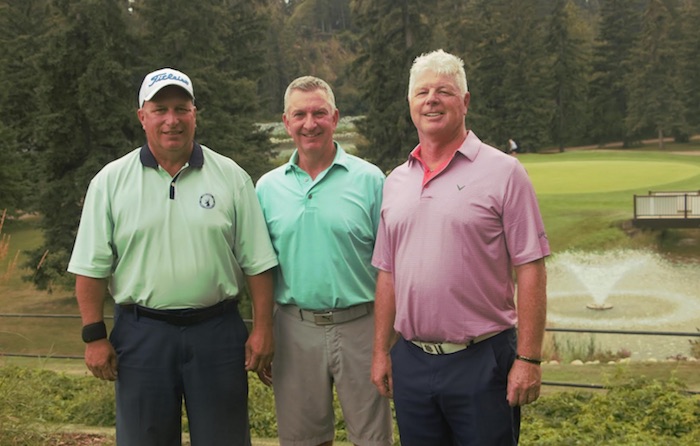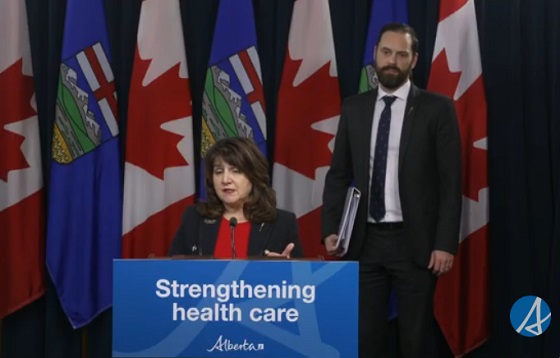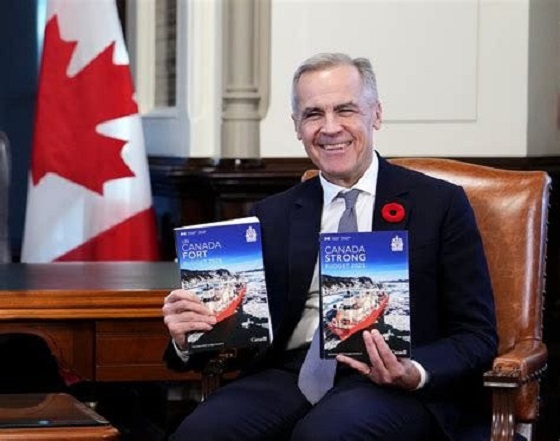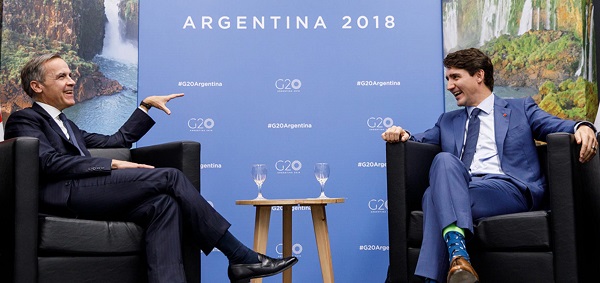Alberta
Local golfers head to national championship

Grant Lee, Ken Griffith, Peter Innes (Club President and Senior Championship competitor)
News release from the Red Deer Golf & Country Club
The 2022 Canadian Men’s Senior Championship hosted by Red Deer Golf & Country Club
Five members of the Red Deer Golf & Country Club have qualified to play in the 2022 Canadian Men’s Senior Championship, presented by BDO, September 5-9, 2022, at the Red Deer Golf & Country Club. These players will be among the one hundred fifty-six male amateur golfers aged 55 and over who qualified for this national championship. The field will include the finest Canadian Senior Golfers from across the country and international players from the United States. The champion will earn a coveted exemption into the 2023 U.S. Senior Amateur Championship.
Ken Griffith, Grant Lee and Peter Innes competed and qualified for the championship at the Alberta Golf Provincial qualifier in Medicine Hat and Tom Skinner and Joe Gascon earned their way by qualifying through an exemption competition at the RDGCC Club Championship in August. “This is a
major accomplishment for our Club,” says Head Professional, Dean Manz. “To have five players from our Club participate in this national championship is recording setting for our Club (for us), and it speaks to the high caliber of golf played at our Club.”

Joe Gascon, Tom Skinner
Other notable central Alberta golfers who qualified for this championship include, Frank Van Dornick, Camrose Golf Club, Keith Newton, Olds Golf Club.
The attached Backgrounder provides a summary of the accomplishments for RDGCC golfers.
A complete list of all Player’s competing can be viewed:
https://gc-2022canadianmensseniorchampionshippre.golfgenius.com/pages/8185216125898901540
The Canadian Men’s Senior Championship has been held since 1962 and has become one of Canada’s most popular amateur golf events. The Senior Championship is played over 72 holes with a cut after 36 holes. The Super Senior Championship is contested concurrently during the championship. The Senior Inter-Provincial Team Championship, established in 1977, runs concurrently with the first 36 holes of the tournament.
Over 100 volunteers from both the Red Deer Golf & Country Club and the community will be on hand to host the National and International competitors and their families.
We thank our local sponsors, the City of Red Deer, ATB, Kipp Scott, Red Deer Golf & Country Club, NOVA Chemicals, Apex Oilfield Services, Roll’n Oilfield Services, Copies Now, Heck Petroleum, IFR Workwear, Phone Experts, Reid & Wright Advertising, Red Deer Bottling for support of this national
championship.
Ken Griffith
2022 Red Deer Golf and Country Club Men’s Championship – (Champion)
2022 Red Deer Golf and Country Club Senior Club Championship – (Champion)
2022 Alberta Senior Amateur Championship – (3rd place, Interprovincial Team Member)
2022 Alberta Mid Master Championship – (5th place)
2022 Alberta Mid Amateur Championship – (18 place)
2021 Central Alberta Senior Open Championship – (Champion)
2021 Alberta Senior Amateur Championship – (2nd place, Interprovincial Team Member)
2021 Alberta Mid Amateur Championship – (18 place)
2021 Red Deer Golf and Country Club Senior Club Championship – (Champion)
2021 Olds Senior Amateur Open Championship – (Champion)
2020 Alberta Senior Amateur Championship – (T 4th place)
2020 Central Alberta Senior Amateur Championship – (3rd place)
2020 Alberta Mid Amateur Championship – (18th place)
2020 Alberta Mid Master Amateur Championship – (3rd place)
2020 Red Deer Golf and Country Club Senior Club Championship – (Champion)
2019 Canadian Senior Amateur Championship – (9th place)
2019 Canadian Senior Amateur Championship – Interprovincial Team Championship – (Champion)
2019 Alberta Senior Amateur Provincial Championship – (Champion)
2019 Central Alberta Senior Amateur Championship – (Champion, Interprovincial Team Member)
2019 Alberta Mid Amateur Championship – (17 place)
2019 Alberta Mid Master Amateur Championship – (3rd place)
2019 Red Deer Golf and Country Club Senior Club Championship – (Champion)
2018 Canadian Senior Amateur Championship – (5th place)
2018 Canadian Senior Amateur Championship – Interprovincial Team Championship – (2nd place)
2018 Canadian Mid Amateur Championship – (28th place)
2018 Alberta Senior Amateur Provincial Championship – (3rd place, Interprovincial Team Member)
2018 Central Alberta Senior Amateur Championship – (Champion)
2018 Alberta Mid Amateur Championship – (8th place)
2018 Alberta Mid Master Championship – (2nd place)
2018 New Zealand Senior Amateur Championship – (5th place)
2017 Canadian Senior Amateur Championship – (15th place)
2017 Canadian Senior Amateur Championship – Interprovincial Team Championship – (Champion)
2017 Alberta Senior Amateur Provincial Championship (3rd place, Interprovincial Team Member)
2017 Central Alberta Senior Amateur Championship – (Champion)
2017 Alberta Springs Golf Course Club Championship – (Champion)
Alberta
Alberta introducing dual practice health care model to increase options and shorten wait times while promising protection for publicly funded services

Enhancing access through dual practice
If passed, Bill 11, the Health Statutes Amendment Act, 2025 (No. 2), would modernize physician participation rules to give doctors flexibility to work in both the public system and private settings. Dual practice would allow physicians to continue providing insured services through the provincial health insurance plan while also delivering private services.
Alberta’s government has looked to proven models in other jurisdictions to guide the development of a model that strengthens access while safeguarding the public system. Dual practice exists in New Brunswick and Quebec and is widely used in countries with top-performing health systems, including Denmark, the Netherlands, United Kingdom, France, Germany, Spain and Australia.
“For years, governments across Canada have tried to fix long wait times by spending more money, yet the problem keeps getting worse. Alberta will not accept the status quo. Dual practice gives us a practical, proven tool that lets surgeons do more without asking taxpayers to pay more. It means shorter waits, better outcomes and a stronger health system for everyone.”
If passed, this dual practice model would be closely monitored to protect Alberta’s public health care system. The government, for example, would ensure that dual practice physicians maintain separate records for the services they provide, so no public funding subsidizes private services.
Bill 11 would include provisions to restrict participation, which could include:
- Mandating that surgeons in dual practice must perform a dedicated number or ratio of surgeries in the public system to be eligible to perform surgeries privately.
- Restricting specialties to public practice if shortages would compromise public care.
- Potentially restricting private practice to evenings, weekends or to underutilized rural sites, as required.
Alberta’s government remains committed to its public health guarantee: No Albertan will ever have to pay out of pocket to see their family doctor or to get the medical treatment they need. These proposed changes comply with the Canada Health Act.
Alberta’s government is also committed to getting Alberta’s dual practice model right and to taking a thoughtful approach to ensure the best path forward. At this time, family medicine providers will not be eligible to be flexible participants within this new model. The priority is to focus on making sure all Albertans have access to a primary care provider. Additionally, surgeries for life-threatening conditions such as cancer and emergency procedures will remain entirely publicly funded with no private option available.
“Albertans are waiting too long for the health care they need, so we are taking bold and decisive action to shorten wait times, increase access and give Albertans more choices over their own health care. At the same time, we will continue building a strong public health system where no one is denied access to the services they need because of an inability to pay.”
If passed, Bill 11 would create new options for doctors and patients. It would expand Alberta’s health system to provide more care by allowing doctors to treat more patients. Each time a patient chooses to pay for care in a private clinic or a clinic operating on evenings and weekends, for example, resources would be freed up so another patient could receive publicly funded care. This proposed new model would also support physician attraction and retention.
“As dual practice enhances flexibility for Albertans, physicians and medical professionals, safeguards will be established and utilized to protect and grow hospital and public health system capacity.”
“Albertans deserve choice and timely access to safe care, whether in a private or public setting. With the creation of the dual practice model, we can extend treatment options to patients while helping hospitals focus their resources on the highest-acuity patients.”
“I believe all options to improve access to health care for Albertans should be on the table. Therefore, the government’s dual practice legislation is a welcome option. Appropriate guardrails must be in place to ensure the spirit of the Canada Health Act is maintained.”
Quick facts
- Physicians would continue to bill the provincial plan for public services and may offer private services separately.
- Physicians may still choose to work entirely in public or entirely in private settings.
Proposed legislation would modernize physician rules, drug coverage, food safety and health cards while improving oversight and administration in Alberta’s health system.
If passed, Bill 11, the Health Statutes Amendment Act, 2025 (No. 2), would amend several pieces of legislation to reflect Alberta’s evolving health needs, strengthen the ability of health care professionals to deliver care and improve accountability and efficiency across the system.
“This legislation represents a new era for health care in Alberta. By putting patients first and supporting providers, we are improving transparency, flexibility and access. With modernized physician rules, stronger drug coverage, enhanced food safety and better health information sharing, Albertans will have world-class care.”
Protecting drug coverage for Albertans
If passed, amendments would improve coordination between public and private drug plans, ensuring taxpayer-funded programs are used efficiently and remain available for those who need them most.
Private plans would become the first payer for individuals who have them, with public programs acting as a safety net. The legislation would also protect older Albertans by ensuring employers cannot reduce or terminate health benefits for employees aged 65 and older who remain actively employed.
“People shouldn’t be punished for getting older – it’s that straightforward. With this legislation, we’re protecting Albertans by ensuring employers can no longer kick folks off their health benefits when they need them most.”
Ensuring consistent billing and remuneration practices
Alberta’s government is also proposing amendments to the Alberta Health Care Insurance Act to ensure health care providers and clinics are not engaging in improper billing practices and making inappropriate claims. The proposed amendments would strengthen accountability and transparency while generating cost savings by introducing penalties for systemic non-compliance.
Strengthening food safety in Alberta
If passed, amendments to the Public Health Act and related regulations would strengthen food safety across all establishments by improving training for staff, increasing transparency of inspection results and giving inspectors new tools for oversight and investigation.
The changes would also update the Food Regulation, Food Retail and Food Services Code, Institutions Regulation and create a new Public Health Investigator Regulation, ensuring consistent standards, better reporting and increased public confidence in Alberta’s food safety system.
“Enhancing food safety in Alberta is an important step to making sure Albertans have the safeguards and protections in place to keep them healthy and well. If passed, these amendments to the Public Health Act will ensure food establishments are following best practices and that enforcement measures are in place to support proper food safety.”
Improving health cards and information sharing
If passed, the legislation would create a new process for health card renewal, prevent card misuse and allow cards to be seized or suspended if tampered with. The changes would also permit information sharing with the ministries of Technology and Innovation and Service Alberta and Red Tape Reduction to support continued efforts to modernize health cards.
Amendments to the Health Information Act would support a more integrated health care system and seamless patient experience to help improve care for Albertans who are accessing the system.
It would also add new authority to enable health foundations to better connect with patients to support innovation and advancement of care in their community in an appropriate manner, in accordance with the requirements set out in regulations.
“Albertans generously support enhancements to health care delivery, innovation and research in their communities each year. We look forward to working with our health partners across the continuum to better communicate with grateful patients. With these changes, we will join other Canadian jurisdictions in connecting patients with health foundations in their community while ensuring the strongest protection of Albertans’ private health data.”
Advancing a new era of health care
If passed, proposed amendments to the Alberta Health Care Insurance Act and the Provincial Health Agencies Act would support operational changes to implement previously announced objectives like transitioning Alberta Health Services to a hospital-based acute care service provider.
The proposed amendments would also result in the repealing of the Hospitals Act, as all hospital governance and operational provisions would be moved into the Provincial Health Agencies Act.
New dual practice model to increase access and choice
The Health Statutes Amendment Act, 2025 (No. 2) includes proposed amendments to the Alberta Health Care Insurance Act that would modernize how physicians participate in Alberta’s publicly funded health insurance plan. The changes would introduce a new dual practice model, giving physicians greater flexibility to provide care in both public and private settings while maintaining safeguards to ensure Albertans continue to have access to publicly funded health services.
Alberta
Premier Smith explains how private clinics will be introduced in Alberta

Premier Smith and Hospitals and Surgical Health Services Minister Matt Jones laid out Alberta’s new dual practice model for surgeons. This change will let doctors perform more surgeries, cut wait times, keep talent in Alberta, and move patients through the system faster, all while protecting publicly funded care.
-

 Carbon Tax2 days ago
Carbon Tax2 days agoCarney fails to undo Trudeau’s devastating energy policies
-

 Business1 day ago
Business1 day agoBudget 2025: Ottawa Fakes a Pivot and Still Spends Like Trudeau
-

 armed forces2 days ago
armed forces2 days agoCanada At Risk Of Losing Control Of Its Northern Territories
-

 Health1 day ago
Health1 day agoTens of thousands are dying on waiting lists following decades of media reluctance to debate healthcare
-

 International2 days ago
International2 days agoCanada’s lost decade in foreign policy
-

 Opinion1 day ago
Opinion1 day agoLandmark 2025 Study Says Near-Death Experiences Can’t Be Explained Away
-

 International4 hours ago
International4 hours ago“The Largest Funder of Al-Shabaab Is the Minnesota Taxpayer”
-

 Alberta5 hours ago
Alberta5 hours agoPremier Smith explains how private clinics will be introduced in Alberta








